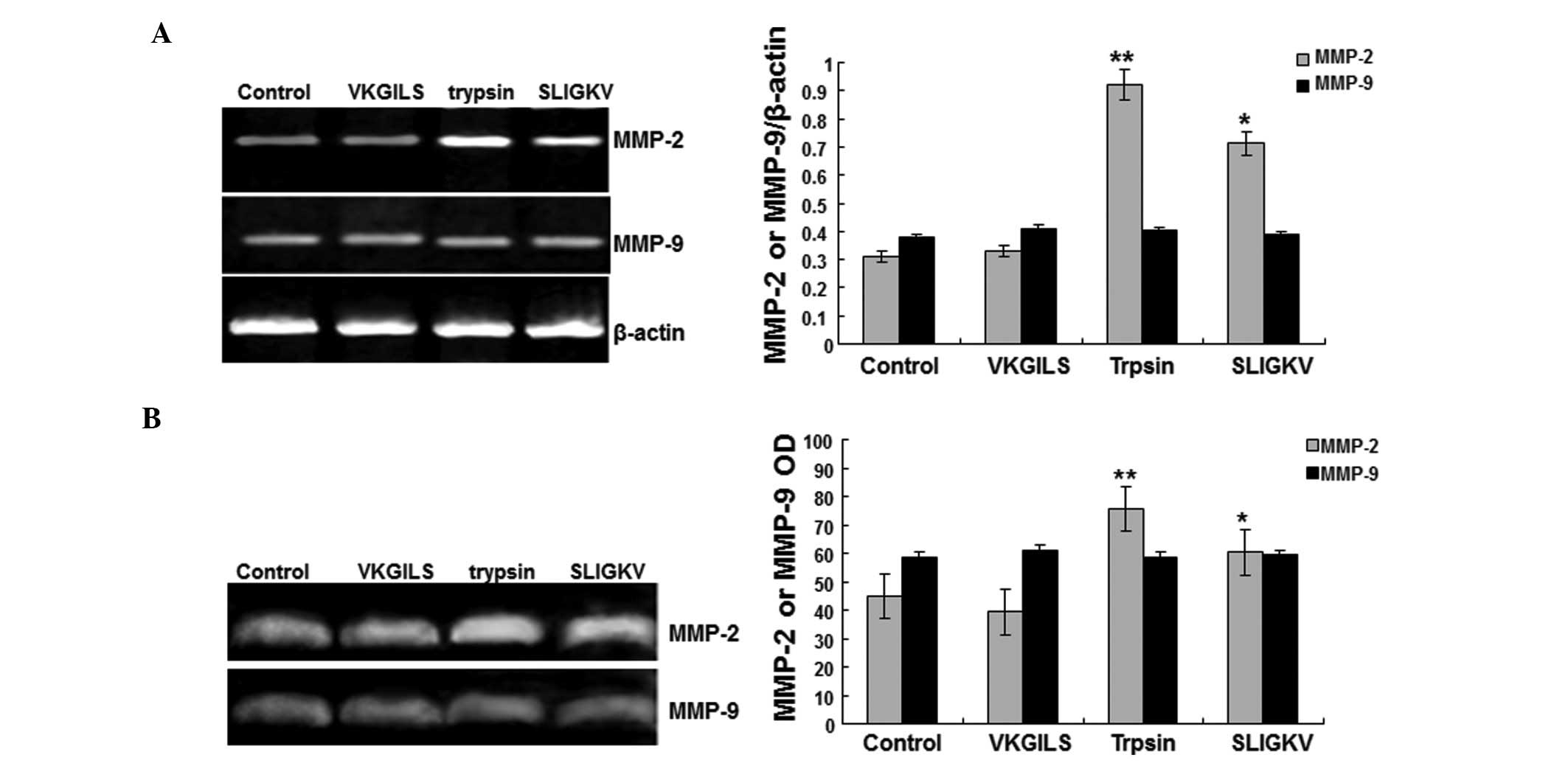|
1
|
Yada K, Shibata K, Matsumoto T, Ohta M,
Yokoyama S and Kitano S: Protease-activated receptor-2 regulates
cell proliferation and enhances cyclooxygenase-2 mRNA expression in
human pancreatic cancer cells. J Surg Oncol. 89:79–85. 2005.
View Article : Google Scholar : PubMed/NCBI
|
|
2
|
Xu Y, Liu Z and Guo K: Inhibition of JDP2
to epithelial-to-mesenchymal transition of the TGF-β1-induced
pancreatic cancer cell line Panc-1. World J Gastroenterol.
19:2931–2936. 2011.
|
|
3
|
Zheng YM, Xie LQ, Zhao JY, et al: Effect
of protease activated receptor-2 agonists on proliferation of
hepatoma cells. Zhonghua Gan Zang Bing Za Zhi. 17:701–702. 2009.(In
Chinese). PubMed/NCBI
|
|
4
|
Zhou J, Xie L, Li X, et al: Promotion of
protease-activated receptor 2 agonists on cell invasion and
metastasis of esophageal cancer cell EC109. Shi Jie Hua Ren Xiao
Hua Za Zhi. 18:1313–1319. 2010.
|
|
5
|
Chen HT, Tsou HK, Tsai CH, et al: Thrombin
enhanced migration and MMPs expression of human chondrosarcoma
cells involves PAR receptor signaling pathway. J Cell Physiol.
223:737–745. 2010.PubMed/NCBI
|
|
6
|
Kirkland JG, Cottrell GS, Bunnett NW and
Corvera CU: Agonists of protease-activated receptors 1 and 2
stimulate electrolyte secretion from mouse gallbladder. Am J
Physiol Gastrointest Liver Physiol. 293:G335–G346. 2007. View Article : Google Scholar : PubMed/NCBI
|
|
7
|
Soreide K, Janssen EA, Körner H and Baak
JP: Trypsin in colorectal cancer: molecular biological mechanisms
of proliferation, invasion, and metastasis. J Pathol. 209:147–156.
2006. View Article : Google Scholar : PubMed/NCBI
|
|
8
|
Albini A, et al: A rapid in vitro assay
for quantitating the invasive potential of tumor cells. Cancer Res.
47:3239–3245. 1987.PubMed/NCBI
|
|
9
|
Nishibori M, Mori S and Takahashi HK:
Physiology and pathophysiology of proteinase-activated receptors
(PARs): PAR-2-mediated proliferation of colon cancer cell. J
Pharmacol Sci. 97:25–30. 2005. View Article : Google Scholar : PubMed/NCBI
|
|
10
|
Kaufmann R, Oettel C, Horn A, et al: Met
receptor tyrosine kinase transactivation is involved in
proteinase-activated receptor-2-mediated hepatocellular carcinoma
cell invasion. Carcinogenesis. 30:1487–1496. 2009. View Article : Google Scholar : PubMed/NCBI
|
|
11
|
Hofmann UB, Westphal JR, et al: Expression
and activation of matrix metalloproteinase-2 (MMP-2) and its
co-localization with membrane-type 1 matrix metalloproteinase
(MT1-MMP) correlate with melanoma progression. J Pathol.
191:245–256. 2000. View Article : Google Scholar : PubMed/NCBI
|
|
12
|
Jung JY, Kim HS, Roh MR, Roh HJ, Lee SY
and Chung KY: The effect of imiquimod on matrix metalloproteinases
and tissue inhibitors of metalloproteinases in malignant melanoma
cell invasion. Ann Dermatol. 26:363–373. 2014. View Article : Google Scholar : PubMed/NCBI
|
|
13
|
Bramhall SR, Stamp GW, Dunn J, Lemoine NR
and Neoptolemos JP: Expression of collagenase (MMP2), stromelysin
(MMP3) and tissue inhibitor of the metalloproteinases (TIMP1) in
pancreatic and ampullary disease. Br J Cancer. 73:972–978. 1996.
View Article : Google Scholar : PubMed/NCBI
|
|
14
|
Koshiba T, Hosotani R, Wada M, et al:
Involvement of matrix metallproteinase-2 activity in invasion and
metastasis of pancreatic carcinoma. Cancer. 82:642–650. 1998.
View Article : Google Scholar : PubMed/NCBI
|
|
15
|
Suh SJ, Kwak CH, Chung TW, et al: Pimaric
acid from Aralia cordata has an inhibitory effect on TNF-α-induced
MMP-9 production and HASMC migration via down-regulated NF-κB and
AP-1. Chem Biol Interact. 199:112–119. 2012. View Article : Google Scholar : PubMed/NCBI
|
|
16
|
Han S, Lee CW, Trevino JG, Hughes SJ and
Sarosi GA Jr: Autocrine extra-pancreatic trypsin 3 secretion
promotes cell proliferation and survival in esophageal
adenocarcinoma. PLoS One. 8:e766672013. View Article : Google Scholar : PubMed/NCBI
|















